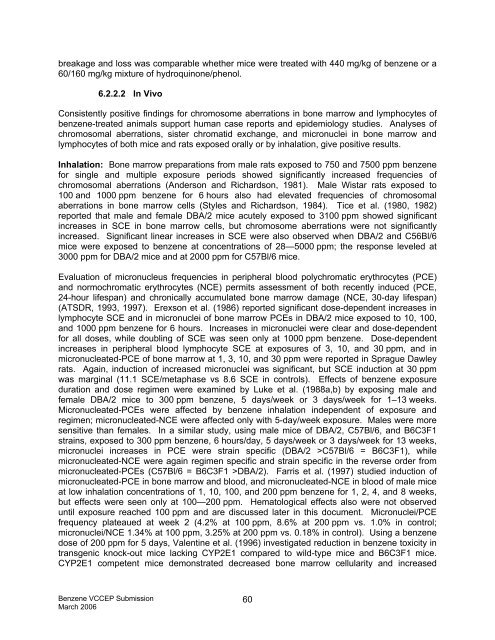(VCCEP) Tier 1 Pilot Submission for BENZENE - Tera
(VCCEP) Tier 1 Pilot Submission for BENZENE - Tera
(VCCEP) Tier 1 Pilot Submission for BENZENE - Tera
You also want an ePaper? Increase the reach of your titles
YUMPU automatically turns print PDFs into web optimized ePapers that Google loves.
eakage and loss was comparable whether mice were treated with 440 mg/kg of benzene or a<br />
60/160 mg/kg mixture of hydroquinone/phenol.<br />
6.2.2.2 In Vivo<br />
Consistently positive findings <strong>for</strong> chromosome aberrations in bone marrow and lymphocytes of<br />
benzene-treated animals support human case reports and epidemiology studies. Analyses of<br />
chromosomal aberrations, sister chromatid exchange, and micronuclei in bone marrow and<br />
lymphocytes of both mice and rats exposed orally or by inhalation, give positive results.<br />
Inhalation: Bone marrow preparations from male rats exposed to 750 and 7500 ppm benzene<br />
<strong>for</strong> single and multiple exposure periods showed significantly increased frequencies of<br />
chromosomal aberrations (Anderson and Richardson, 1981). Male Wistar rats exposed to<br />
100 and 1000 ppm benzene <strong>for</strong> 6 hours also had elevated frequencies of chromosomal<br />
aberrations in bone marrow cells (Styles and Richardson, 1984). Tice et al. (1980, 1982)<br />
reported that male and female DBA/2 mice acutely exposed to 3100 ppm showed significant<br />
increases in SCE in bone marrow cells, but chromosome aberrations were not significantly<br />
increased. Significant linear increases in SCE were also observed when DBA/2 and C56Bl/6<br />
mice were exposed to benzene at concentrations of 28—5000 ppm; the response leveled at<br />
3000 ppm <strong>for</strong> DBA/2 mice and at 2000 ppm <strong>for</strong> C57Bl/6 mice.<br />
Evaluation of micronucleus frequencies in peripheral blood polychromatic erythrocytes (PCE)<br />
and normochromatic erythrocytes (NCE) permits assessment of both recently induced (PCE,<br />
24-hour lifespan) and chronically accumulated bone marrow damage (NCE, 30-day lifespan)<br />
(ATSDR, 1993, 1997). Erexson et al. (1986) reported significant dose-dependent increases in<br />
lymphocyte SCE and in micronuclei of bone marrow PCEs in DBA/2 mice exposed to 10, 100,<br />
and 1000 ppm benzene <strong>for</strong> 6 hours. Increases in micronuclei were clear and dose-dependent<br />
<strong>for</strong> all doses, while doubling of SCE was seen only at 1000 ppm benzene. Dose-dependent<br />
increases in peripheral blood lymphocyte SCE at exposures of 3, 10, and 30 ppm, and in<br />
micronucleated-PCE of bone marrow at 1, 3, 10, and 30 ppm were reported in Sprague Dawley<br />
rats. Again, induction of increased micronuclei was significant, but SCE induction at 30 ppm<br />
was marginal (11.1 SCE/metaphase vs 8.6 SCE in controls). Effects of benzene exposure<br />
duration and dose regimen were examined by Luke et al. (1988a,b) by exposing male and<br />
female DBA/2 mice to 300 ppm benzene, 5 days/week or 3 days/week <strong>for</strong> 1–13 weeks.<br />
Micronucleated-PCEs were affected by benzene inhalation independent of exposure and<br />
regimen; micronucleated-NCE were affected only with 5-day/week exposure. Males were more<br />
sensitive than females. In a similar study, using male mice of DBA/2, C57Bl/6, and B6C3F1<br />
strains, exposed to 300 ppm benzene, 6 hours/day, 5 days/week or 3 days/week <strong>for</strong> 13 weeks,<br />
micronuclei increases in PCE were strain specific (DBA/2 >C57Bl/6 = B6C3F1), while<br />
micronucleated-NCE were again regimen specific and strain specific in the reverse order from<br />
micronucleated-PCEs (C57Bl/6 = B6C3F1 >DBA/2). Farris et al. (1997) studied induction of<br />
micronucleated-PCE in bone marrow and blood, and micronucleated-NCE in blood of male mice<br />
at low inhalation concentrations of 1, 10, 100, and 200 ppm benzene <strong>for</strong> 1, 2, 4, and 8 weeks,<br />
but effects were seen only at 100—200 ppm. Hematological effects also were not observed<br />
until exposure reached 100 ppm and are discussed later in this document. Micronuclei/PCE<br />
frequency plateaued at week 2 (4.2% at 100 ppm, 8.6% at 200 ppm vs. 1.0% in control;<br />
micronuclei/NCE 1.34% at 100 ppm, 3.25% at 200 ppm vs. 0.18% in control). Using a benzene<br />
dose of 200 ppm <strong>for</strong> 5 days, Valentine et al. (1996) investigated reduction in benzene toxicity in<br />
transgenic knock-out mice lacking CYP2E1 compared to wild-type mice and B6C3F1 mice.<br />
CYP2E1 competent mice demonstrated decreased bone marrow cellularity and increased<br />
Benzene <strong>VCCEP</strong> <strong>Submission</strong><br />
March 2006<br />
60





